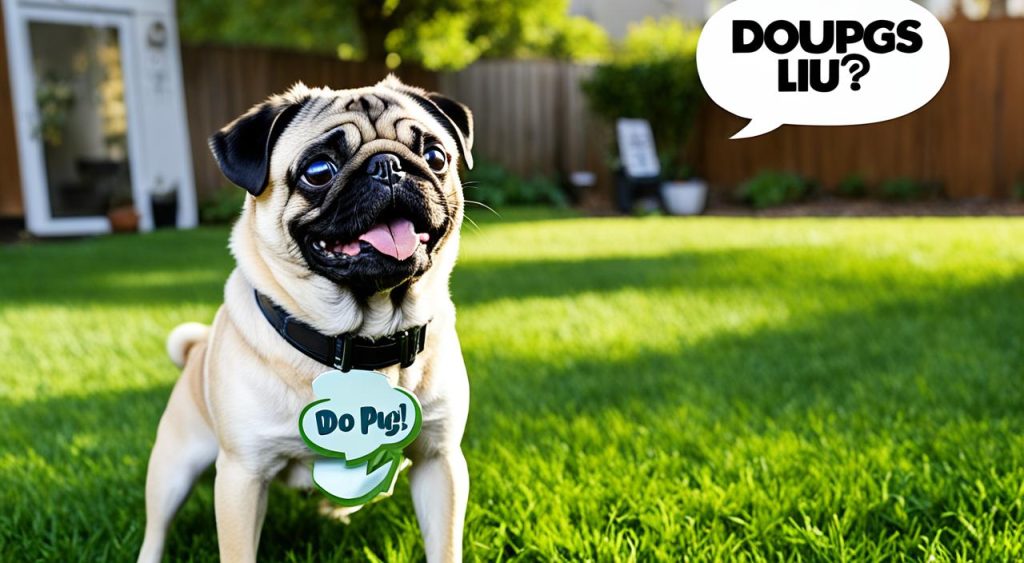Pugs are known for their adorable wrinkled faces and playful demeanor, but they are also notorious for their barking habits. If you’re a pug owner or considering bringing one into your home, it’s essential to understand why pugs bark and how to manage excessive barking.
Pugs communicate primarily through barking, using their vocalizations to express a range of emotions and needs. From seeking attention to expressing boredom or frustration, fear or protectiveness, playfulness or excitement, and even health concerns, pugs have a unique way of communicating through their distinctive barks.
But what does a pug bark sound like? Pugs have a rapid and barky sound, which is often described as a yappy machine gun. Additionally, they have distinct whines, screams, and squealy whimpering sounds that further contribute to their vocal repertoire.
Understanding the reasons behind pug barking is crucial for effective management and control. With that knowledge, you can address the root causes of excessive barking and implement techniques to train your pug to reduce their barking. Through patience, consistency, and positive reinforcement, you can create a peaceful environment in your home.
Key Takeaways:
- Pugs are vocal dogs and use barking as a primary means of communication.
- Pug barks are distinctive, with a rapid and barky sound.
- Common triggers for pug barking include seeking attention, boredom, fear, playfulness, and health issues.
- Effective management techniques include understanding the triggers, positive reinforcement training, and mental and physical stimulation.
- Health-related issues should be addressed by a vet to manage excessive barking.
What Does a Pug Bark Sound Like? Identifying Pug Vocalizations
When it comes to vocalizing, pugs have a unique style that sets them apart. Their bark is often described as rapid and resembling a yappy machine gun. But that’s not all – pugs also have a range of other vocalizations that they use to communicate with their owners.
Aside from barking, pugs can emit distinct whines, screams, and squealy whimpering sounds. These vocalizations may vary depending on the situation and the pug’s emotions at the time. Understanding these sounds is crucial for pug owners, as it can help them decipher their furry friend’s needs and feelings.
“My pug’s bark is like a mix of a bark and a squeal. It’s quite adorable and impossible to ignore!” – Pug Owner
To get a clearer idea of what pug barking sounds like, pug owners can turn to various resources. Online platforms often have videos or audio clips of pugs barking, allowing owners to familiarize themselves with the distinct sound. Additionally, some websites even offer pug barking sound downloads, enabling owners to listen to these vocalizations anytime or anywhere.
By becoming acquainted with the different vocalizations of pugs, owners can better respond to their pet’s needs and ensure effective communication.
Reasons Why Pugs Bark Excessively: Common Triggers
Pugs, like any other dog breed, may bark excessively due to various triggers. Understanding these common triggers can help address the root cause of excessive barking in pugs, allowing you to better manage and control their barking habits.
Seeking Attention or Demanding Something
Pugs are known to be attention seekers, and one of the main reasons for their excessive barking is their desire to get your attention or to demand something from you. Whether it’s wanting to play, needing to go outside, or looking for a treat, pugs may resort to barking to communicate their needs. By consistently addressing their needs and providing appropriate attention, you can help reduce their barking tendencies.
Feeling Bored or Frustrated
Pugs are energetic dogs that require mental and physical stimulation. When they feel bored or frustrated due to a lack of activity or mental engagement, they may resort to excessive barking as a form of release or expression. Providing regular exercise, interactive toys, and engaging activities can help alleviate their boredom and reduce their barking.
Experiencing Fear or Protectiveness
Like many small dog breeds, pugs can be prone to fear and may have a protective nature. When they feel threatened or perceive a potential danger, they may respond by barking excessively. It’s important to socialize your pug from a young age, expose them to various situations, and provide reassurance and positive experiences to help them feel more secure and less likely to bark excessively out of fear or protectiveness.
Displaying Playfulness or Excitement
Pugs are generally playful and exuberant dogs, and sometimes their barking can be a result of their excitement or anticipation. Whether it’s seeing their favorite toy, meeting new people, or playtime with other dogs, pugs may express their joy through barking. While it’s natural for them to be excited, teaching them alternative ways to communicate their excitement, such as using quieter commands, can help reduce excessive barking in such situations.
Potential Health Issues
Excessive barking can also be a sign of underlying health issues in pugs. Conditions such as Canine Cognitive Dysfunction (similar to Alzheimer’s in humans) or deafness can cause pugs to bark more frequently or at inappropriate times. If you notice persistent excessive barking despite your efforts to address behavioral triggers, it’s crucial to consult a veterinarian to rule out any potential health concerns.
By identifying and addressing these common triggers for excessive barking in pugs, you can help create a more peaceful and harmonious environment for both you and your furry companion.
Managing and Training Pugs to Reduce Barking
If you are dealing with excessive barking in your pug, it’s essential to implement effective management and training techniques. By understanding the underlying reasons for barking and using positive reinforcement methods, you can effectively control and reduce your pug’s barking behavior.
“Investigate the underlying reasons for barking.”
The first step in managing pug barking is to identify the triggers and reasons behind it. Pugs may bark to seek attention, express boredom or frustration, or even due to fear or protectiveness. By observing their behavior and environment, you can determine the root cause of the excessive barking.
“Provide appropriate attention and stimuli.”
One effective way to reduce pug barking is to provide them with appropriate attention and mental stimulation. Engage in interactive play sessions, offer puzzle toys, and ensure they have plenty of physical exercise. This will help redirect their energy and provide an outlet for their natural instincts.
“Use positive reinforcement training methods.”
Training using positive reinforcement techniques is crucial in teaching your pug to reduce barking. Reward quiet behavior with treats, praises, and affection. This will reinforce the idea that being quiet is desirable and make the training process more enjoyable for both you and your pug.
“Teach quieter commands.”
Teaching your pug quieter commands can also aid in controlling barking. Instead of using the command “speak,” introduce a command such as “quiet” or “enough.” Consistently practice these commands during training sessions to reinforce the behavior of staying quiet when instructed.
“Provide mental and physical stimulation.”
Keep your pug mentally and physically stimulated to prevent boredom-related barking. Offer brain-teasing toys, interactive games, and regular exercise routines. A tired and satisfied pug is less likely to resort to excessive barking out of boredom or frustration.
Remember to be patient and consistent in your training efforts. Avoid punishment or yelling at your pug, as it can worsen their barking behavior and damage the bond you share. With time and dedication, you can effectively manage and train your pug to reduce excessive barking, creating a more peaceful environment for both you and your furry friend.
Using Bark Collars for Excessive Pug Barking
When it comes to managing excessive barking in pugs, some owners may consider using bark collars as a last resort. However, it is crucial to choose the right type of collar to ensure your pug’s well-being. Shock collars should be avoided as they can be painful, causing unnecessary distress to your furry friend.
Instead, opting for vibrating bark collars can be a safer alternative. These collars use gentle vibrations to redirect your pug’s attention and discourage barking. They are designed to be more humane and provide a more comfortable experience for your pet.
It is important to use bark collars with caution, following a few guidelines to ensure their effectiveness and your pug’s safety:
1. Charge the collar properly: Ensure that the collar is fully charged before use to ensure consistent functionality.
2. Supervise collar usage: Do not leave the collar on your pug unsupervised to prevent any potential accidents or discomfort.
3. Avoid using on wet dogs: Remove the collar when your pug is wet to avoid any potential harm or damage to the collar.
Bark collars should be used as a temporary measure while focusing on proper training and behavior modification. They can be a helpful tool in addressing excessive barking, but it’s important to complement their usage with positive reinforcement training methods and mental and physical stimulation.
Remember, your pug’s well-being and comfort should always be a top priority when exploring different methods to control their barking. With the right approach, you can help your pug become a calmer and more content member of your family.
Dealing With Health-Related Barking in Pugs
Sometimes, pug barking can be a symptom of health issues like Canine Cognitive Dysfunction or deafness. It’s important to have a vet evaluate your pug’s health if excessive barking persists despite training efforts. Identifying and addressing any underlying health conditions can significantly improve the barking behavior.
“A comprehensive health examination by a qualified veterinarian is crucial in determining the root cause of your pug’s excess barking.”
For pugs with dementia, creating a stable and familiar environment can help manage their barking. Routines and structure can provide a sense of security to these dogs. In some cases, medication may be prescribed by the vet to alleviate symptoms and reduce barking.
“Providing a calming and predictable environment is key in managing excessive barking in pugs with dementia.”
When dealing with pugs with deafness, it’s essential to adapt training methods to include visual cues or light flashes. Teaching quiet commands using visual signals can be effective in reducing barking episodes.
“Modifying training techniques to accommodate deafness can lead to better communication and reduced barking.”
Dealing With Multiple Barking Pugs in a Grumble
Pugs are social dogs that often bark in groups or “grumbles.” When one pug starts barking, it can trigger others to join in, creating a chorus of noise. Managing and stopping barking in a grumble can be challenging, but it is possible with the right approach.
It’s important to train each pug individually and reward quiet behavior. By focusing on each pug’s training, you can help them understand that barking is not the desired behavior. Consistency in training is key to achieving results.
“Training each pug individually and reinforcing calm behavior can help reduce barking in a grumble.”
Patience is crucial when dealing with multiple barking pugs. It may take time for them to unlearn the habit of barking as a group. By consistently training and rewarding quiet behavior, you can gradually reduce barking in the grumble.
Separate training sessions for each pug can be beneficial. This allows you to focus on each pug’s specific needs and progress at their own pace. It’s also important to create a calm environment during training sessions and reduce any potential triggers that could lead to barking.
With time, patience, and consistent training, you can address excessive barking in a grumble and create a more peaceful environment with your pugs.
Conclusion
Pugs are naturally vocal dogs and have a tendency to bark for various reasons. However, understanding the triggers for excessive barking and implementing appropriate training and management techniques can help reduce and control their barking behavior.
One important aspect of managing pug barking is providing both mental and physical stimulation. Engaging your pug in interactive play, daily exercise, and puzzle toys can help alleviate boredom and reduce the need for excessive barking.
Using positive reinforcement training methods, such as rewarding quiet behavior and teaching quieter commands, can also be effective in managing pug barking. It’s crucial to avoid punishment or yelling, as this can worsen the barking behavior and create a negative association with training.
If your pug’s barking persists despite training efforts, it’s important to consider any underlying health-related issues. Canine Cognitive Dysfunction and deafness can sometimes contribute to excessive barking in pugs. Consulting with a veterinarian and addressing these health concerns can help in managing the barking effectively.
Lastly, if you have multiple pugs that tend to bark in a group or grumble, it’s essential to train each pug individually and reward quiet behavior. Patience and consistency are key in subduing the barking behavior in a group, as well as creating a calm environment for training sessions.
By implementing these strategies and approaches with patience and consistency, you can successfully manage your pug’s barking habits, creating a peaceful and harmonious living environment for both you and your furry companion.





